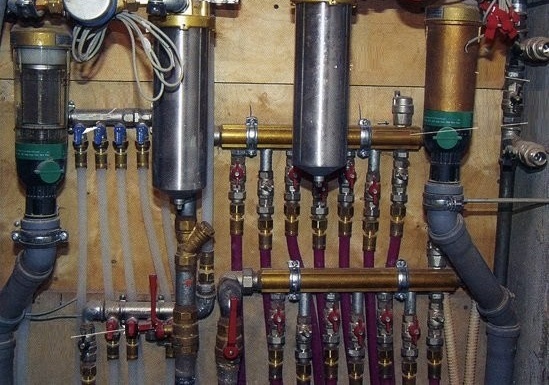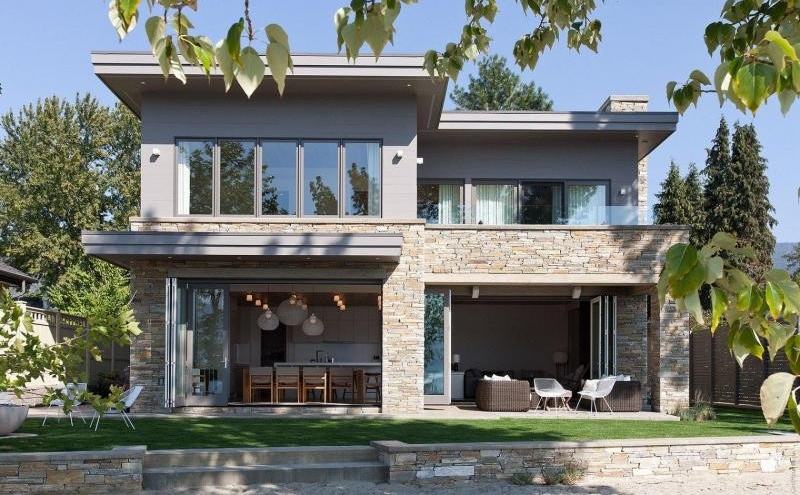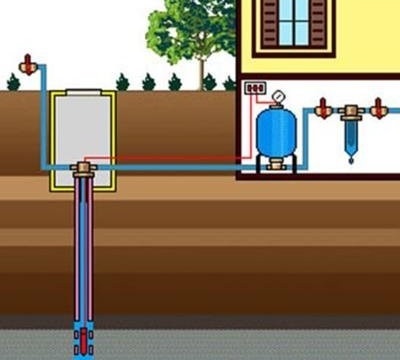How to design a boiler house heat scheme for a private house + some automation examples
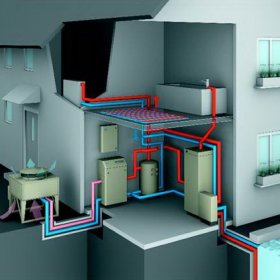
If a country house is used not just for summer holidays, but for year-round permanent residence, it is worth considering the construction of a private boiler room. A properly designed and installed boiler plant will be able to service all the necessary communications: heating systems, hot and cold water supply, ventilation. In order to prevent errors in the installation of equipment and correctly calculate the technical nuances, a thermal diagram of the boiler room with an indication of the main devices and materials must first be drawn up.
General design considerations
Each step of the installation of the boiler installation should be thought out, so you should not try to design communications and install the equipment yourself, it is better to turn to specialists who have vast experience in installing engineering systems for private cottages. They will give a number of valuable tips, for example, help to choose the most optimal model of the boiler and determine the place of its installation.
Suppose, for a small country house, a wall-mounted apparatus is enough, which can easily be located in the kitchen. A two-story cottage, respectively, needs a specially allocated room, which is necessarily equipped with ventilation, chimney, separate exit and window. There should be enough space to accommodate the remaining components: pumps, boiler, connecting elements, pipes, etc.
The boiler house design process for a private house includes several points:
- preparation of the boiler room diagram regarding the location inside the house;
- equipment distribution scheme indicating the main technical characteristics;
- specification for the materials and equipment used.
In addition to the acquisition of system components and their installation, as well as graphic work, among which there should be a circuit diagram, professionals will help with the preparation of the necessary documents.
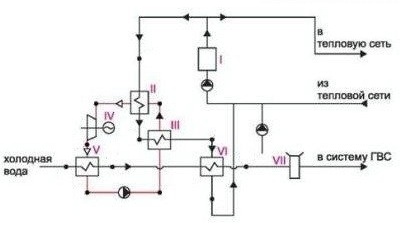
An example of the concept of a boiler room: I - a boiler; II - water evaporator; III - source water heater; IV - heat engine; V is the capacitor; VI - heater (optional); VII - battery tank
More information on the boiler house concept
A correctly composed graphic drawing should primarily reflect all mechanisms, devices, apparatuses and pipes connecting them. Standard boiler house schemes for private houses include a set of boilers, circulating, recirculation, make-up and network pumps, accumulator and condensation tanks, fuel supply and combustion devices, devices for water deaeration, heat exchangers, fans, control panels, heat panels. The choice and location of the equipment is influenced by the type of coolant and thermal communications, as well as the quality of the water used.

In the process of drawing up a diagram of a hot water boiler, it is necessary to monitor the conformity of the technical characteristics of the equipment, which must meet the requirements of the selected temperature regime
Water-based heating networks can be divided into two groups:
- open, in which fluid is sampled at local installations;
- closed, in which water, giving up heat, returns to the boiler.
An example of a concept can be an example of an open-type boiler room. A circulation pump is installed on the return line, which ensures the delivery of water to the boiler and further through the system. The calculated temperature regime of this circuit is 155-70 ° С. Two types of jumpers (recirculation and bypass) connect the two main lines - supply and return.
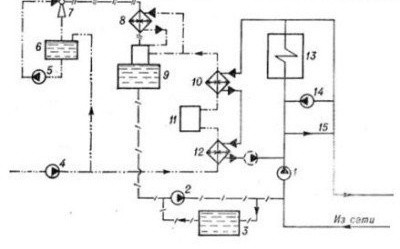
Schematic diagram of the boiler room: 1 - network pump; 2 - make-up pump; 3 - make-up water tank; 4 - source water pump; 5 - feed pump; 6 - supply tank; 7 - ejector; 8 - cooler; 9 - vacuum deaerator; 10 - purified water heater; 11 - cleaning filter; 12 - source water heater; 13 - hot water boiler; 14 - recirculation pump; 15 - bypass
Tips for operating a thermal circuit
Due to the occurrence of flue gases, corrosion of metal coatings of sulphate or low temperature origin may occur. To avoid its appearance, you should control the temperature of the water. The optimal value at the entrance to the boiler is 60-70˚С. To increase the temperature to the required parameters, it is necessary to install a recirculation pump.
In order for boilers to serve for a long time, efficiently and economically, you should monitor the constancy of water flow. The minimum flow rate is set by the equipment manufacturer.
For the best operation of boiler plants, vacuum deaerators are used. A water-jet ejector creates a vacuum, and the generated steam is used for deaeration.
Automation of boiler equipment
It would be foolish not to take advantage of the opportunities that facilitate the operation of heating systems. Automation allows you to use a set of programs that control heat fluxes depending on the mode of the day, weather conditions, and also help to additionally heat individual rooms, for example, a swimming pool or a nursery.
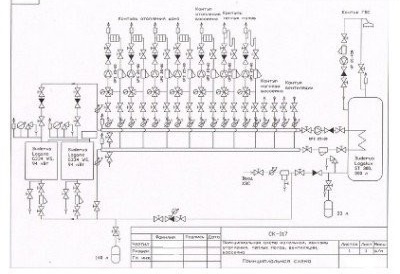
An example of a basic automated scheme: an automatic operation mode of a boiler room controls the operation of water recirculation, ventilation, water heating circuits, a heat exchanger, 2 floor heating circuits, 4 building heating circuits
There is a list of user functions that adapt the operation of the equipment depending on the lifestyle of the inhabitants of the house. For example, in addition to the standard program for providing hot water, there is a set of individual solutions that are more convenient and even economical for residents. For this reason, a boiler house automation scheme can be developed with a choice of one of the popular modes.
Good Night Program
It is proved that the optimal night temperature in the room should be several degrees lower than the daytime temperature, that is, the ideal option is to lower the temperature in the bedroom by about 4 ° C during sleep. At the same time, a person experiences discomfort, waking up in an unusually cool room, therefore, in the early morning temperature must be restored. The inconvenience is easily resolved by automatically switching the heating system to night mode and vice versa. The night time controllers are dealt with by DE DIETRICH and BUDERUS.
Hot Water Priority System
Automatic control of hot water flows is also one of the functions of the overall automation of equipment. It is divided into three types:
- priority, in which during use of hot water the heating system is completely turned off;
- mixed, when the boiler capacities are delimited to service water heating and home heating;
non-priority, in which both systems work together, but in the first place is the heating of the building.
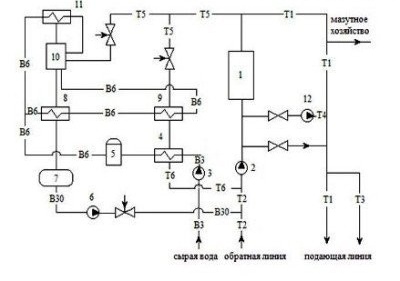
Automated scheme: 1 - boiler; 2 - network pump; 3 - source water pump; 4 - heater; 5 - block HVO; 6 - make-up pump; 7 - block deaeration; 8 - cooler; 9 - heater; 10 - deaerator; 11 - condensate cooler; 12 - recirculation pump
Low temperature operating modes
The transition to low-temperature programs is becoming the main focus of the latest developments of boiler manufacturers. The advantage of this approach is the economic nuance - reducing the consumption of fuel. Just automation allows you to adjust the temperature, select the correct mode and thereby reduce the heating level. All of the above items must be taken into account at the stage of drawing up the thermal diagram of the boiler room.
